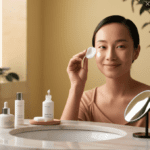- Consistency is critical. Most patients see improvement over several weeks or months.
-
Sun protection is non-negotiable. Without it, melasma can worsen despite treatment.
-
Tailored treatments win. Sensitivity, genetics, and treatment history all play a role in how well kojic acid works for you.
Melasma can feel like an uphill battle, but if you’ve heard whispers about kojic acid being the ultimate solution, you’re not alone. Dermatologists have plenty to say about this intriguing ingredient. Let’s break down the insights of ten top experts to see how kojic acid measures up in the fight against melasma.
Dr. Jared Jagdeo: Kojic Acid as a Hero Complement
Dr. Jared Jagdeo sees kojic acid as a “hero” agent—but not the leading star. It works best as part of a team, integrated into broader treatment plans that may include laser therapies 1.
Here’s the timeline: Patients using kojic acid can expect noticeable improvement within 4 to 6 weeks, with even better results after a year. Side effects like irritation are rare for most, but Dr. Jagdeo stresses the importance of formulations designed to minimize these risks. The bottom line? Kojic acid shines when it complements other treatments, making it a great sidekick in achieving treating melasma.

Dr. Lim: The Power of Combination Therapy
For Dr. Lim, kojic acid works better in combo treatments. In a study with 40 women battling melasma, he combined 2% kojic acid, 10% glycolic acid, and 2% hydroquinone in a gel. The results? Impressive. After 12 weeks, 60% of patients experienced noticeable improvement. By comparison, only 47.5% showed improvement without kojic acid. Takeaway: Kojic acid isn’t just effective—it amplifies results when paired with other pigmentation-fighting ingredients.
Dr. Moore: Tyrosinase Inhibitor with Cautions
Dr. Moore explains that kojic acid reduces melanin production by acting as a tyrosinase inhibitor, helping to lighten areas affected by melasma. However, he doesn’t recommend it as a first-line treatment. Instead, he suggests turning to kojic acid when hydroquinone or glycolic acid fail to deliver results. There’s a caveat: contact dermatitis can be a side effect for some, so sun protection is a must during treatment.
Top Benefits of Kojic Acid for Skin Health
Dr. Suryaningsih: Genetics and Tailored Treatments
Dr. Suryaningsih highlights how genetic factors can influence melasma, making tailored treatments crucial. She finds kojic acid beneficial for inhibiting tyrosinase activity in melanocytes 2. But here’s her key point: strict sun protection is non-negotiable. Since UV rays can worsen melasma, combining kojic acid with sun safety measures is essential. Her advice? Personalize kojic acid use based on individual responses and genetics to get the best results.
Dr. Burnett: Efficacy Meets Safety
Safety is Dr. Burnett’s top priority. He emphasizes that kojic acid is generally safe at concentrations up to 4%, but going beyond that could lead to irritation or even long-term skin damage. His advice: stick to reputable formulations that prioritize safety. Balancing efficacy with minimal risk is the key to making kojic acid work for melasma without unintended side effects.
Dr. Kirsch: Patience Is Key
Dr. Kirsch has seen positive outcomes with kojic acid, especially in patients who didn’t achieve results with other treatments. His timeline for improvement? Several months. That’s why setting realistic expectations and educating patients about consistency is critical. Pairing kojic acid with sun protection measures is also non-negotiable in his book.
Dr. Saeedi: A Safe Option for Sensitive Skin
Sensitive skin types, rejoice! Dr. Saeedi recommends low-concentration kojic acid (around 1%) as a gentler option for treating melasma. He warns about irritation, so his advice is to introduce kojic acid gradually into skincare routines to test tolerance. For those with easily reactive skin, this low-strength approach could be a game-changer.
Dr. Gupta: Synergy with Hydroquinone
Dr. Gupta is all about enhancing results with combination therapy. His research shows that pairing kojic acid with hydroquinone is far more effective than using either ingredient alone. In a 12-week study, patients using this combo saw significant improvements in pigmentation and overall skin tone. What does this mean for melasma? Two is better than one, especially when it comes to kojic acid and hydroquinone.
Dr. Nascimento: The Antioxidant Advantage
Kojic acid does more than lighten skin—it doubles as an antioxidant, says Dr. Nascimento. This dual action makes it a go-to for patients looking for non-invasive treatments. Plus, it works well with advanced options like laser therapies, making it a versatile ingredient in melasma management.
Dr. Chen: The Power of Combinations
For Dr. Chen, kojic acid shines as part of combination regimens, especially for patients who haven’t responded well to traditional therapies. Her practice focuses on patient education, particularly on maintaining results. Sunscreen and consistent skincare routines are the backbone of any effective melasma treatment, including kojic acid.
So, Does Kojic Acid Work for Melasma?
The verdict from the dermatologists is clear: yes, kojic acid works—but it’s not a magic bullet. Its strength lies in its ability to complement other treatments, whether it’s combined with hydroquinone, glycolic acid, or laser therapies. Dermatologists agree: while kojic acid may not always be the first line of defense, it’s a powerful ally in the fight against melasma when used thoughtfully and consistently.
What are your thoughts on using kojic acid for melasma? Have you tried it as part of a treatment plan? Share your experiences in the comments below!

I’m a devoted organic skincare enthusiast, passionate about the natural, wholesome goodness that organic products bring to our skin.
Organic skincare isn’t just a hobby for me—it’s a lifestyle. Every product I use, recommend, and write about has been carefully chosen for its purity and effectiveness. Everything I write about is backed by scientific studies, dermatologists’ opinions, and user experiences.
I also excel at tackling skincare challenges with innovative, organic solutions.


